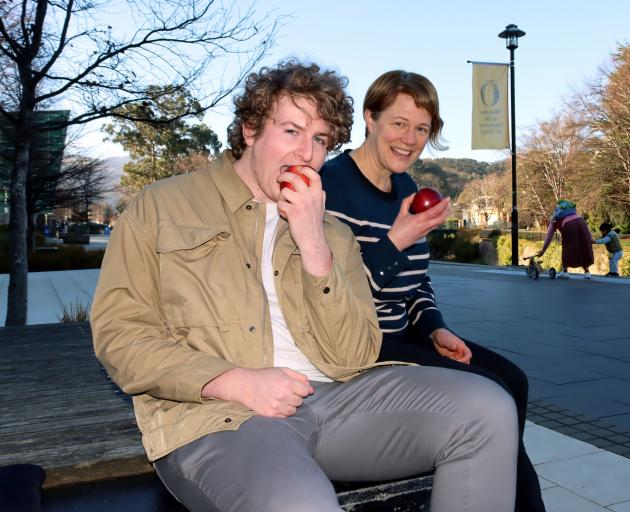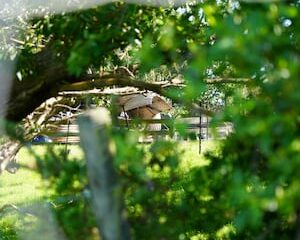Science
Researcher Explores 300 Apple Varieties in New Zealand Orchard

A significant research project is underway at the Jim Dunckley Heritage Orchard in New Zealand, where Aaron Hewson, a master’s student in plant biotechnology, is analysing over 300 apple varieties. This orchard, established 25 years ago by the Coastal Otago Branch of the New Zealand Tree Crops Association, is believed to house one of the most diverse collections of apple cultivars in the country.
Hewson’s research aims to assist in the preservation and propagation of these heritage cultivars, ensuring their identification through genetic methods. Many of the varieties in the orchard were gathered in the 1990s by the late Jim Dunckley from various locations across Otago and Southland, with a significant number sourced from an old Plant & Food Research orchard in Clyde.
“Some trees have names given by local farmers, often referencing nearby landmarks,” explained Hewson. “These names do not always align with the actual genetics.” He provided an example where a well-known apple, Granny Smith, was found to be genetically identical to a cultivar named Lord Lambourne, suggesting potential misnaming in the classification of these varieties.
To examine the genetic makeup of the apple trees, samples were collected by staff and students from the University of Otago’s Plant Biochemistry Lab. These samples were labelled, freeze-dried, and subsequently sent to a laboratory in France for analysis, facilitated by Plant & Food Research, which is now part of the Bioeconomy Science Institute.
Hewson acknowledged the valuable support of his co-supervisor, Dr. Elena Lopez-Girona from Plant & Food Research. “Her expertise has been instrumental throughout this process,” he noted. The research team utilized a SNP chip technology to check around 50,000 known DNA hotspots in each apple leaf. This method generates a quick genetic fingerprint, allowing researchers to determine if two trees belong to the same variety.
The local collection of apple cultivars is particularly important due to stringent biosecurity regulations that restrict the import of new genetics. Hewson highlighted the global context of apple diversity, stating, “There are approximately 10,000 different apple varieties across the world, yet all commercial varieties trace back to only six original apples. This makes our genetic base extremely narrow.”
Associate Professor Lynnette Brownfield, another co-supervisor, emphasized the significance of identifying the genetic makeup within the orchard. “Given that commercial apples in New Zealand stem from a limited genetic pool, understanding the varieties in this orchard may help breeders discover new genetic traits, including disease resistance, which could expand future breeding options.”
The Coastal Otago Branch of the New Zealand Tree Crops Association, which owns the orchard, will decide how to apply the information gathered from this research. The goal is to assign unique identifiers to all trees, creating a comprehensive understanding of the collection. This will facilitate collaboration with apple breeders, from backyard growers to organizations such as Plant & Food Research, and enable the provision of germplasm as needed.
As this research progresses, it holds promise not only for the preservation of heritage apple varieties but also for enhancing the genetic diversity of future apple breeding efforts in New Zealand.
-

 World1 week ago
World1 week agoPrivate Funeral Held for Dean Field and His Three Children
-

 Top Stories2 weeks ago
Top Stories2 weeks agoFuneral Planned for Field Siblings After Tragic House Fire
-

 Sports3 months ago
Sports3 months agoNetball New Zealand Stands Down Dame Noeline Taurua for Series
-

 Entertainment3 months ago
Entertainment3 months agoTributes Pour In for Lachlan Rofe, Reality Star, Dead at 47
-

 Entertainment2 months ago
Entertainment2 months agoNew ‘Maverick’ Chaser Joins Beat the Chasers Season Finale
-

 Sports3 months ago
Sports3 months agoSilver Ferns Legend Laura Langman Criticizes Team’s Attitude
-

 Sports1 month ago
Sports1 month agoEli Katoa Rushed to Hospital After Sideline Incident During Match
-

 World2 weeks ago
World2 weeks agoInvestigation Underway in Tragic Sanson House Fire Involving Family
-

 Politics2 months ago
Politics2 months agoNetball NZ Calls for Respect Amid Dame Taurua’s Standoff
-

 Top Stories2 weeks ago
Top Stories2 weeks agoShock and Grief Follow Tragic Family Deaths in New Zealand
-

 Entertainment3 months ago
Entertainment3 months agoKhloe Kardashian Embraces Innovative Stem Cell Therapy in Mexico
-

 World4 months ago
World4 months agoPolice Arrest Multiple Individuals During Funeral for Zain Taikato-Fox





















